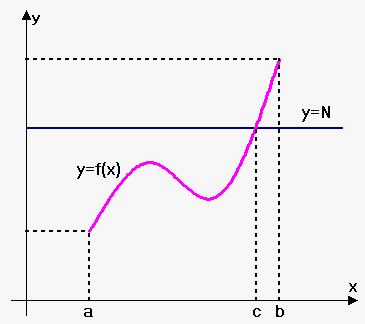Theorems involving Continuous Functions
Intermediate Value Theorem. Suppose that $$$f$$$ is continuous on closed interval $$${\left[{a},{b}\right]}$$$ and let $$${N}$$$ is any number between $$${f{{\left({a}\right)}}}$$$ and $$${f{{\left({b}\right)}}}$$$ (or $$${f{{\left({b}\right)}}}$$$ and $$${f{{\left({a}\right)}}}$$$; depends what is bigger). Then there exists number $$${c}$$$ in $$${\left({a},{b}\right)}$$$ such that $$${f{{\left({c}\right)}}}={N}$$$.
 The Intermediate Value Theorem states that a continuous function takes on every intermediate value between the function values $$${f{{\left({a}\right)}}}$$$ and $$${f{{\left({b}\right)}}}$$$.
The Intermediate Value Theorem states that a continuous function takes on every intermediate value between the function values $$${f{{\left({a}\right)}}}$$$ and $$${f{{\left({b}\right)}}}$$$.
Note that the value $$${N}$$$ can be taken one or more times.
In geometric terms Intermediate Value Theorem states that if any horizontal line $$${y}=$$$ is given between $$${f{{\left({a}\right)}}}$$$ and $$${f{{\left({b}\right)}}}$$$ then the graph of $$${f{}}$$$ should intersect $$${y}={N}$$$ somewhere.
Corollary. Suppose that $$${f{}}$$$ is continuous on closed interval $$${\left[{a},{b}\right]}$$$ such that $$${f{{\left({a}\right)}}}$$$ and $$${f{{\left({b}\right)}}}$$$ have different signs. Then there exists number $$${c}$$$ in $$${\left({a},{b}\right)}$$$ such that $$${f{{\left({c}\right)}}}={0}$$$.
Proof of this fact is straightforward. Since $$${f{{\left({a}\right)}}}$$$ and $$${f{{\left({b}\right)}}}$$$ have different signs then either $$${f{{\left({a}\right)}}}<{0}<{f{{\left({b}\right)}}}$$$ or $$${f{{\left({b}\right)}}}<{0}<{f{{\left({a}\right)}}}$$$, so, we take $$${N}={0}$$$ in intermediate value theorem.
Note, that Intermediate Value Theorem is general false for discontinuous functions.
One use of the Intermediate Value Theorem is in locating roots of equations.
Example 1. Function $$${{2}}^{{x}}-{4}{x}={0}$$$ clearly has root 4, but it is harder to locate another root. However, for function $$${f{{\left({x}\right)}}}={{2}}^{{x}}-{4}{x}$$$ $$${f{{\left({0}\right)}}}={{2}}^{{0}}-{4}\cdot{0}={1}>{0}$$$ and $$${f{{\left(\frac{{1}}{{2}}\right)}}}={{2}}^{{\frac{{1}}{{2}}}}-{4}\cdot{2}=\sqrt{{{2}}}-{8}<{0}$$$.
Thus, by corollary (because function $$${f{{\left({x}\right)}}}={{2}}^{{x}}-{4}{x}$$$ is continuous) there exists number $$${c}$$$ in interval $$${\left({0},\frac{{1}}{{2}}\right)}$$$ such that $$${f{{\left({c}\right)}}}={0}$$$.
Example 2. Show that the root of equation $$${\cos{{\left({x}\right)}}}-{x}={0}$$$ is within interval [0,1].
Let $$${f{{\left({x}\right)}}}={\cos{{\left({x}\right)}}}-{x}$$$. Clearly it is continuous on [0,1].
We are looking for the solution of the equation, that is a number $$${c}$$$ between 0 and 1 such that $$${f{{\left({c}\right)}}}={0}$$$.
Since $$${f{{\left({0}\right)}}}={\cos{{\left({0}\right)}}}-{0}={1}>{0}$$$ and $$${f{{\left({1}\right)}}}={\cos{{\left({1}\right)}}}-{1}<{0}$$$ then $$${f{{\left({1}\right)}}}<{0}<{f{{\left({0}\right)}}}$$$.
Thus, according to corollary there exists number $$${c}$$$ on interval $$${\left({0},{1}\right)}$$$ such that $$${f{{\left({c}\right)}}}={0}$$$. Therefore, $$${f{{\left({x}\right)}}}$$$ has at least one root in (0,1).
Boundedness of a function. Suppose that function $$${f{}}$$$ is continuous on closed interval $$${\left[{a},{b}\right]}$$$ then exist such constant finite numbers $$${m}$$$ and $$${M}$$$ that $$${m}\le{f{{\left({x}\right)}}}\le{M}$$$ for all $$${a}\le{x}\le{b}$$$.
Note that this theorem doesn't hold if interval is not closed.
For example, let $$${f{{\left({x}\right)}}}={\left\{\begin{array}{c}\frac{{1}}{{x}}{\quad\text{if}\quad}{0}<{x}\le{1}\\{0}{\quad\text{if}\quad}{x}={0}\\ \end{array}\right.}$$$.
This function can take only finite values, but it grows without a bound when $$${x}$$$ approaches 0.
